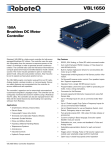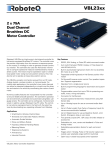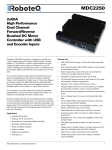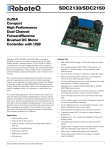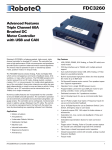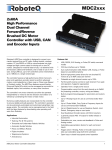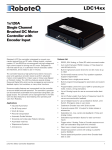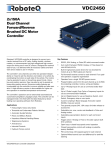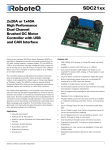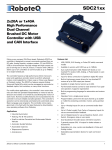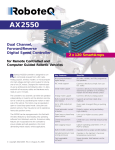Download Datasheet - Robot MarketPlace
Transcript
VBL16xx 150A Forward/Reverse Brushless DC Motor Controller Roboteq’s VBL16xx is a high-current controller for hall-sensor equipped Brushless DC motors. The controller uses the position information from the sensors to sequence power on the motor’s 3 windings in order to generate smooth continuous rotation. The controller also uses the Hall sensor information to compute speed and measure travelled distance inside a 32-bit counter. The motor may be operated in open or closed loop speed mode. Using low-cost position sensors, they may also be set to operate as heavy-duty position servos. The VBL16xx accepts commands received from an RC radio, Analog Joystick, wireless modem, or microcomputer. Numerous safety features are incorporated into the controller to ensure reliable and safe operation. The controller's operation can be extensively automated and customized using Basic Language scripts. The controller can be configured, monitored and tuned in realtime using a Roboteq’s free PC utility. The controller can also be reprogrammed in the field with the latest features by downloading new operating software from Roboteq. Applications • • • • • • • • • • • Small Electric Vehicles, Electric Bikes Key Features • • Terrestrial and Underwater Robotic Vehicles Automatic Guided Vehicles Police and Military Robots Hazardous Material Handling Robots Telepresence Systems Built-in 3-phase high-power drivers for one brushless DC motor at up to 150A • Trapezoidal switching based on Hall Sensor position information • Full forward & reverse motor control. Four quadrant operation. Supports regeneration • • Operates from a single 10V-50V power source • • Connector for Hall Sensors Accurate speed and Odometry measurement using Hall Sensor data Up to 4 Analog Inputs for use as command and/or feedback • Up to 5 Pulse Length, Duty Cycle or Frequency Inputs for use as command and/or feedback • Up to 6 Digital Inputs for use as Deadman Switch, Limit Switch, Emergency stop or user inputs • Two general purpose 24V, 1.5A output for brake release or accessories • Custom scripting in Basic language. Execution speed 50,000+ lines per second • Selectable min, max, center and deadband in Pulse and Analog modes • Selectable exponentiation factors for each command inputs • Trigger action if Analog, Pulse or Hall counter capture are outside user selectable range (soft limit switches) • Open loop or closed loop speed control operation Hydraulic Pumps control VBL16xx Motor Controller Datasheet Programmable current limit up to 150A for protecting controller, motor, wiring and battery. • Animatronics Industrial Controls Auto switch between RS232, Analog, or Pulse based on user-defined priority • Electric Boats Heavyweight, heavy duty robots RS232, 0-5V Analog, or Pulse (RC radio) command modes 1 • Closed loop position control with encoder, analog or pulse/frequency feedback • Watchdog for automatic motor shutdown in case of command loss • • PID control loop • • • Overtemperature protection • • Configurable Data Logging of operating parameters on RS232 Output for telemetry or analysis Built-in Battery Voltage and Temperature sensors Diagnostic LED Extruded aluminum, heat sinking enclosure for operation harsh shock and temperature environment Optional 12V backup power input for powering safely the controller if the main motor batteries are discharged • Efficient heat sinking. Operates without a fan in most applications. • Power Control wire for turning On or Off the controller from external microcomputer or switch Dustproof and weather resistant. IP51 NEMA rating • • No consumption by output stage when motors stopped • • • • • • Regulated 5V output for powering RC radio, RF Modem or microcomputer • Separate Programmable acceleration and deceleration for each motor • • • Ultra-efficient 3 mOhm ON resistance MOSFETs • • Auto stop if no motion is detected • Power wiring via heavy AWG8 cables 9” (228.5mm) L, 5.5” W (140mm), 1.6” (40mm) H -40o to +85o C operating environment 3 lbs (1,350g) Easy configuration, tuning and monitory using provided PC utility Field upgradeable software for installing latest features via the internet Stall detection and selectable triggered action if Amps is outside user-selected range Short circuit protection with selectable sensitivity levels Overvoltage and Undervoltage protection Orderable Product References 2 Reference Number of Channels Amps/Channel Volts VBL1650 1 150 50 VBL1660 1 150 60 VBL16xx Motor Controller Datasheet Version 1.2. May 17, 2013 Power Wires Identifications and Connection Important Safety Disclaimer Dangerous uncontrolled motor runaway condition can occur for a number of reasons, including, but not limited to: command or feedback wiring failure, configuration error, faulty firmware, errors in user script or user program, or controller hardware failure. The user must assume that such failures can occur and must make his/her system safe in all conditions. Roboteq will not be liable in case of damage or injury as a result of product misuse or failure. Power Wires Identifications and Connection Power connections are made by means of heavy gauge wires located at the back of the controller. Motor Wires U V W (top) VMot Ground Ground Power Control Controller Power FIGURE 8. Rear Controller Layout The diagram below shows how to wire the controller and how to turn power On and Off. VBL16xx Motor Controller Datasheet 3 F2 1A SW1 Main On/Off Switch 1A PwrCtrl/Yellow Note 1 U White/U Ground/Black Motor Backup Battery V Diode >20A Resistor 1K, 0.5W Note 3 Blue/W Note 2 Note 4 Hall Sensors Hall sensor Connector VMot/Red F1 HA/HB/HC GND/+5V SW2 Emergency Contactor or Cut-off Switch Ground/Black + W Green/V Earth Tab Note 5 I/O Connector Main Battery Note 6 Do not Connect! FIGURE 9. Powering the controller. Thick lines identify MANDATORY connections Important Warning Carefully follow the wiring instructions provided in the Power Connection section of the User Manual. The information on this datasheet is only a summary. Mandatory Connections It is imperative that the controller is connected as shown in the above diagram in order to ensure a safe and trouble-free operation. All connections shown as thick black lines line are mandatory. The controller must be powered On/Off using switch SW1on the Yellow wire. Use a suitable high-current fuse F1 as a safety measure to prevent damage to the wiring in case of major controller malfunction. Emergency Switch or Contactor The battery must be connected in permanence to the controller’s Red wires via a high-power emergency switch or contactor SW2 as additional safety measure. The user must be able to deactivate the switch or contactor at any time, independently of the controller state. Precautions and Optional Connections Note 1: Backup battery to ensure motor operation with weak or discharged batteries, connect a second battery to the Power Control wire/terminal via the SW1 switch. Note 2: Use precharge 1K, 0.5W Resistor to prevent switch arcing. Note 3: Insert a high-current diode to ensure a return path to the battery during regeneration in case the fuse is blown. Note 4: Optionally ground the VMot wires when the controller is Off if there is any concern that the motors could be made to spin and generate voltage in excess of 50V (VBL1650) or 60V (VBL1660). 4 VBL16xx Motor Controller Datasheet Version 1.2. May 17, 2013 Use of Safety Contactor for Critical Applications Note 5: Connect the controller’s earth tab to a wire connected to the Earth while the charger is plugged in the AC main, or if the controller is powered by an AC power supply. Note 6: Beware not to create a path from the ground pins on the I/O connector and the battery minus terminal. Use of Safety Contactor for Critical Applications An external safety contactor must be used in any application where damage to property or injury to person can occur because of uncontrolled motor operation resulting from failure in the controller’s power output stage. F2 1A SW1 Main On/Off Switch 1A PwrCtrl Ground Resistor 1K, 0.5W Diode >20A F1 VMot to +40V Max Digital Out I/O Connector + - Ground Main Battery FIGURE 10. Contactor wiring diagram The contactor coil must be connected to a digital output configured to activate when “No MOSFET Failure”. The controller will automatically deactivate the coil if the output is expected to be off and battery current of 2.5A or more is measured for more than 0.5s. This circuit will not protect against other sources of failure such as those described in the “Important Safety Disclaimer” on page 3. Controller Mounting During motor operation, the controller will generate heat that must be evacuated. The published amps rating can only be fully achieved if adequate cooling is provided. Always operate the controller in a well ventilated space so that air can flow between the heatsink fins. Additional conduction cooling can be achieved by having the bottom edges of the case making contact with a metallic surface (chassis, cabinet). Hall Sensors Connection Connection to the Hall Sensors is done using a special connector on the front side of the controller. The figure below shows the location of the various low-voltage connectors and LEDs on the controller. VBL16xx Motor Controller Datasheet 5 P1 Aux Power Communication and I/O Connector Status Hall sensors connector Power and Status LEDs FIGURE 11. Front Controller Layout The Hall sensor connector is a 6-pin Molex Microfit 3.0, model 43645. Pin assignment is in the table below. 6 1 6 1 FIGURE 12. Hall Sensors connector TABLE 4. Pin Number 1 2 3 4 5 6 Signal 5V Reserved Hall C Hall B Hall A Ground Hall Sensor vs Motor Output sequencing The controller requires the Hall sensors inside the motor to be 120 degrees apart. The controller’s 3-phase bridge will activate each of the motor winding according to the sequence shown in the figure below. 1 2 3 4 5 6 1 2 3 4 5 6 Hall A U Hall B 3 1 Hall C U + V W 6 4 + - - + - + - + + + - + - - - + + - + + - 5 W V 2 FIGURE 13. Hall Sensors sequence 6 VBL16xx Motor Controller Datasheet Version 1.2. May 17, 2013 Commands and I/O Connections Commands and I/O Connections Connection to RC Radio, Microcomputer, Joystick and other low current sensors and actuators is done via the 15pin connector located in front of the controller. The functions of many pins vary depending on controller model and user configuration. Pin assignment is found in the table below. 8 1 15 9 FIGURE 14. Connector pin locations TABLE 5. Connector Pin Power 1 9 Dout Com RC Ana Dinput Brake release DOUT2 Safety Contactor 2 TxOut 10 RS232Tx RC5 3 ANA1 DIN5 RxIn 11 ANA4 RC1 12 AnaCmd1 (1) RS232Rx RC4 4 5 Default Config DOUT1 RC3 ANA3 DIN4 Unused DIN1 RCRadio1 DIN3 Unused GND 13 GND 6 14 SCLI Reserved SDAI Reserved 5VOut 7 15 DIN6 8 RC2 ANA2 Unused DIN2 Note 1: Analog command is disabled in factory default configuration. Default I/O Configuration The controller can be configured so that practically any Digital, Analog and RC pin can be used for any purpose. The controller’s factory default configuration provides an assignment that is suitable for most applications. The figure below shows how to wire the controller to an analog potentiometer, an RC radio, the RS232 port, and the Digital output to a motor brake solenoid. You may omit any connection that is not required in your application. The controller automatically arbitrates the command priorities depending on the presence of a valid command signal in the following order: 1-RS232, 2-RC Pulse, 3-None. If needed, use the Roborun+ PC Utility to change the pin assignments and the command priority order. VBL16xx Motor Controller Datasheet 7 RC Ch1 RS232 Ground TxOut RxIn 1 8 1 Brake Release Safety Contactor 15 9 Pot FIGURE 15. Factory default pins assignment Enabling Analog Commands For safety reasons, the Analog command mode is disabled by default. To enable the Analog mode, use the PC utility and set Analog in Command Priority 2 or 3 (leave Serial as priority 1). Note that by default the additional securities are enabled and will prevent the motor from starting unless the potentiometer is centered, or if the voltage is below 0.25V or above 4.75V. The drawing shows suggested assignment of Pot 1 to ANA1. Use the PC utility to enable and assign analog inputs. Status LED Flashing Patterns After the controller is powered on, the Power LED will tun on, indicating that the controller is On. The Status LED will be flashing at a 2 seconds interval. The flashing pattern provides operating or exception status information. Idle - Waiting for Command RS232/USB Mode RC Pulse Mode Analog Mode FIGURE 16. Normal Operation Flashing Patterns Short Detected Overheat Under or Over Voltage Power Stage Off FIGURE 17. Exception or Fault Flashing Patterns Additional status information may be obtained by monitoring the controller with the PC utility. 8 VBL16xx Motor Controller Datasheet Version 1.2. May 17, 2013 Electrical Specifications Electrical Specifications Absolute Maximum Values The values in the table below should never be exceeded, Permanent damage to the controller may result. TABLE 6. Parameter Measure point Models Battery Leads Voltage Ground to VMot Min Typ Max Units VBL1650 50 Volts VBL1660 60 Volts Reverse Voltage on Battery Leads Ground to VMot All -1 Volts Power Control Voltage Ground to Pwr Control wire All 65 Volts Motor Leads Voltage Ground to U, V, W wires VBL1650 50 (1) Volts VBL1660 60 (1) Volts Digital Output Voltage Ground to Output pins All 40 Volts Analog and Digital Inputs Voltage Ground to any signal pin on 15-pin & Hall inputs All 15 Volts RS232 I/O pins Voltage External voltage applied to Rx/Tx pins All 15 Volts Case Temperature Case All 85 oC Humidity Case All 100 (2) % -40 Note 1: Maximum regeneration voltage in normal operation. Never inject a DC voltage from a battery or other fixed source Note 2: Non-condensing Power Stage Electrical Specifications (at 25oC ambient) TABLE 7. Continuous Max Current per channel Measure point Models Min Max Units Battery Leads Voltage Ground to VMot VBL1650 0 (1) 50 Volts VBL1660 0 (1) 60 Volts VBL1650 0 (1) 50 (2) Volts Typ Motor Leads Voltage Ground to U, V, W wires VBL1660 0 (1) 60 (2) Volts Power Control Voltage Ground to Power Control wire All 0 (1) 65 Volts Minimum Operating Voltage VMot or Pwr Ctrl wires All 9 (3) Over Voltage protection range Ground to VMot VBL1650 5 50 (4) 50 Volts VBL1660 5 60 (4) 60 Volts VBL1650 0 5 (4) 50 Volts VBL1660 0 5 (4) 60 Volts 50 100 (5) 150 mA Under Voltage protection range Ground to VMot Volts Idle Current Consumption VMot or Pwr Ctrl wires All ON Resistance (Excluding wire resistance) VMot to U, V or W. Ground to U, V or W All Max Current for 30s Motor current All 150 (6) Amps Continuous Max Current per channel Motor current All 75 (7) Amps VBL16xx Motor Controller Datasheet 3 mOhm 9 TABLE 7. Continuous Max Current per channel Measure point Models Min Typ Max Units Current Limit range Motor current All 10 100 (8) 150 Amps Stall Detection Amps range Motor current All 10 100 (8) 150 Amps Stall Detection timeout range Motor current All 1 65000 (9) 65000 milliseconds Short Circuit Detection threshold (10) Between Motor wires or Between Motor wires and Ground All 280 (11) 800 (11) Amps Short Circuit Detection threshold Between Motor wires and VMot All No Protection. Permanent damage will result Motor Acceleration/Deceleration range Motor Output All 100 500 (12) 65000 milliseconds Note 1: Negative voltage will cause a large surge current. Protection fuse needed if battery polarity inversion is possible Note 2: Maximum regeneration voltage in normal operation. Never inject a DC voltage from a battery or other fixed source Note 3: Minimum voltage must be present on VMot or Power Control wire Note 4: Factory default value. Adjustable in 0.1V increments Note 5: Current consumption is lower when higher voltage is applied to the controller’s VMot or PwrCtrl wires Note 6: Max value is determined by current limit setting. Duration is estimated and is dependent on ambient temperature cooling condition Note 7: Estimate. Limited by case temperature. Current may be higher with better cooling Note 8: Factory default value. Adjustable in 0.1A increments Note 9: Factory default value. Time in ms that Stall current must be exceeded for detection Note 10: Controller will stop until restarted in case of short circuit detection Note 11: Sensitivity selectable by software Note 12: Factory default value. Time in ms for power to go from 0 to 100% Command, I/O and Sensor Signals Specifications TABLE 8. 10 Parameter Measure point Min Typ Max Units Main 5V Output Voltage Ground to 5V pins on 4.6 4.75 4.9 Volts 5V Output Current 5V pins on RJ45 and DSub15 200 (1) mA Digital Output Voltage Ground to Output pins 30 Volts Output On resistance Output pin to ground 0.5 Ohm Output Short circuit threshold Output pin 3.5 Amps Digital Output Current Output pins, sink current 1.5 Amps Input Impedances (except DIN11-19) AIN/DIN Input to Ground Digital Input 0 Level Ground to Input pins -1 1 Volts Digital Input 1 Level Ground to Input pins 3 15 Volts Analog Input Range Ground to Input pins 0 Analog Input Precision Ground to Input pins 0.5 % Analog Input Resolution Ground to Input pins 1 mV Pulse durations Pulse inputs 20000 10 us Pulse repeat rate Pulse inputs 50 250 Hz VBL16xx Motor Controller Datasheet 0.25 1.7 53 kOhm 5.1 Volts Version 1.2. May 17, 2013 Electrical Specifications TABLE 8. Parameter Measure point Pulse Capture Resolution Pulse inputs Frequency Capture Pulse inputs Min Typ Max 1 100 Units us 10000 Hz Note 1: Sum of all 5VOut outputs Operating & Timing Specifications TABLE 9. Parameter Measure Point Min Typ Max Units Command Latency Command to output change 1 0.5 1 ms PWM Frequency Motor Output 10 18 20 kHz Closed Loop update rate Internal RS232 baud rate Rx & Tx pins RS232 Watchdog timeout Rx pin 1000 Hz 115200 (1) 1 (2) Bits/s 65000 ms Note 1: 115200, 8-bit, no parity, 1 stop bit, no flow control Note 2: May be disabled with value 0 Scripting TABLE 10. Parameter Measure Point Scripting Flash Memory Internal Min Max Basic Language programs Internal Integer Variables Internal Boolean Variables Internal Execution Speed Internal 50 000 Parameter Measure Point Min Case Temperature Case Thermal Protection range Case Power Dissipation Case Thermal resistance Humidity Typ Max 8192 1000 Units Bytes 1500 Lines 1024 Words (1) 1024 Symbols 100 000 Lines/s Note 1: 32-bit words Thermal Specifications TABLE 11. Typ Max Units -40 85 (1) oC 80 90 (2) oC 70 Watts Power MOSFETs to case 0.6 oC/W Case 100(3) % Note 1: Thermal protection will protect the controller power Note 2: Max allowed power out starts lowering at minimum of range, down to 0 at max of range VBL16xx Motor Controller Datasheet 11 Mechanical Specifications TABLE 12. Parameter Measure Point Min Typ Weight Case 1.0 (2.0) kg (lbs) Wire Length Case 17 (43) inches (mm) Power Wire Gauge Wire 8 AWG Power Wire Diameter Outside diameter 0.26 (6.6) inches (mm) P1 1.60" (40 mm) Max Units Aux Power Status 4.00" (102 mm) 5.50" (140 mm) FIGURE 18. VBL16xx front view and dimensions 3.00" (76.2 mm) 3.60" (91.4 mm) 4.00" (101.6 mm) 5.50" (140 mm) 0.25" (6.3 mm) 7.00" (177.8 mm) 8.00" (203 mm) 9.00" (228.6 mm) FIGURE 19. VBL16xx top view and dimensions 12 VBL16xx Motor Controller Datasheet Version 1.2. May 17, 2013












